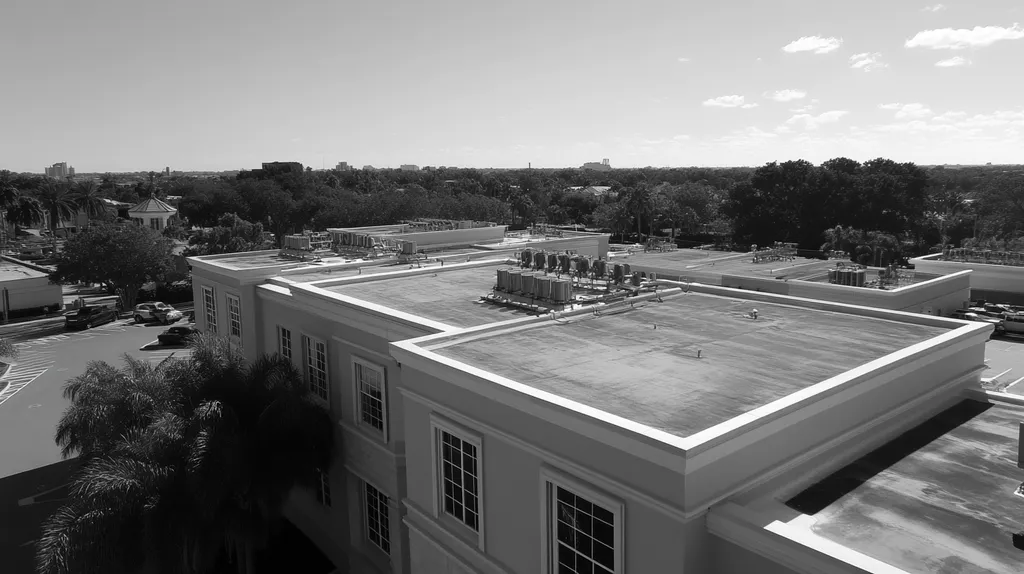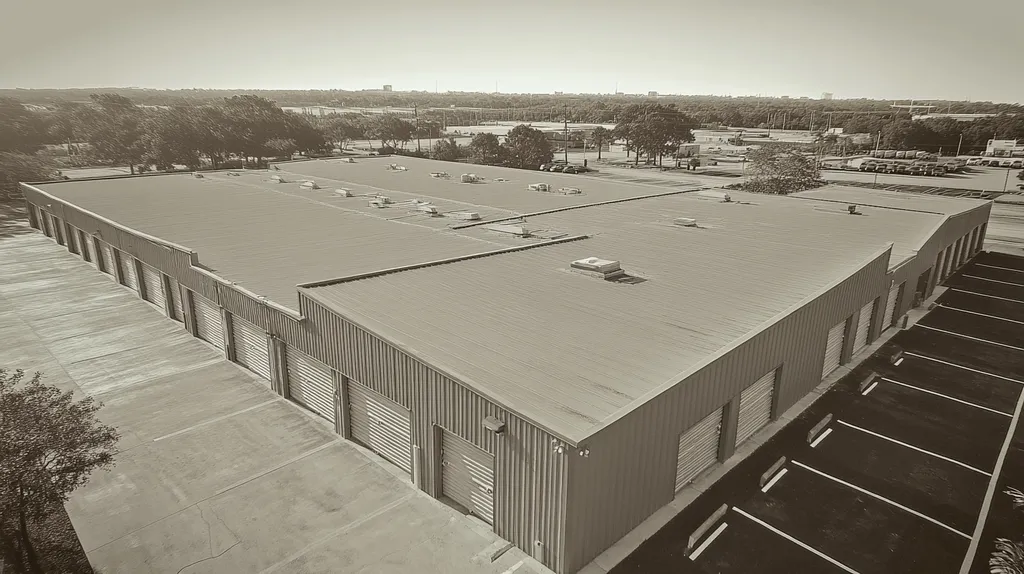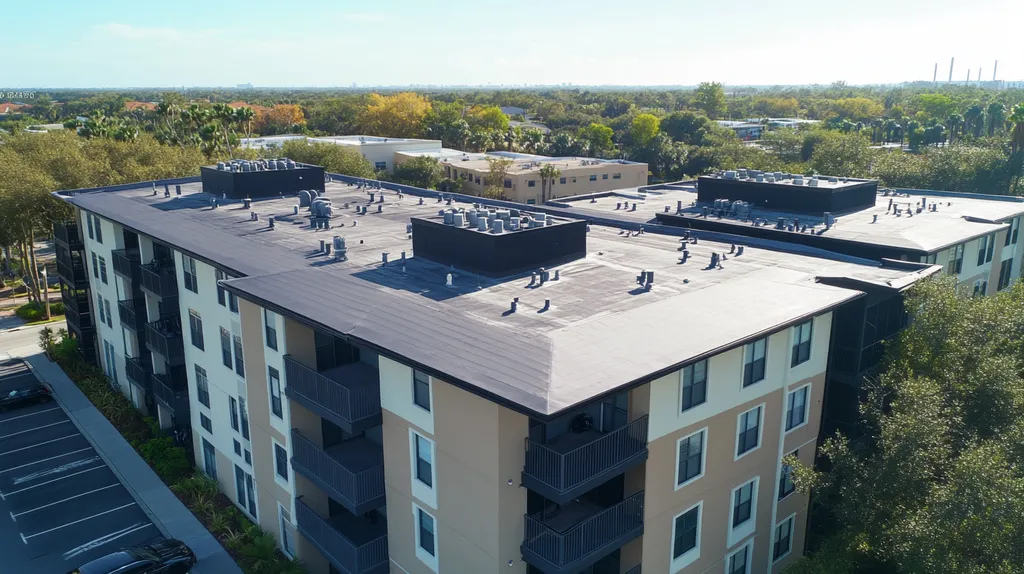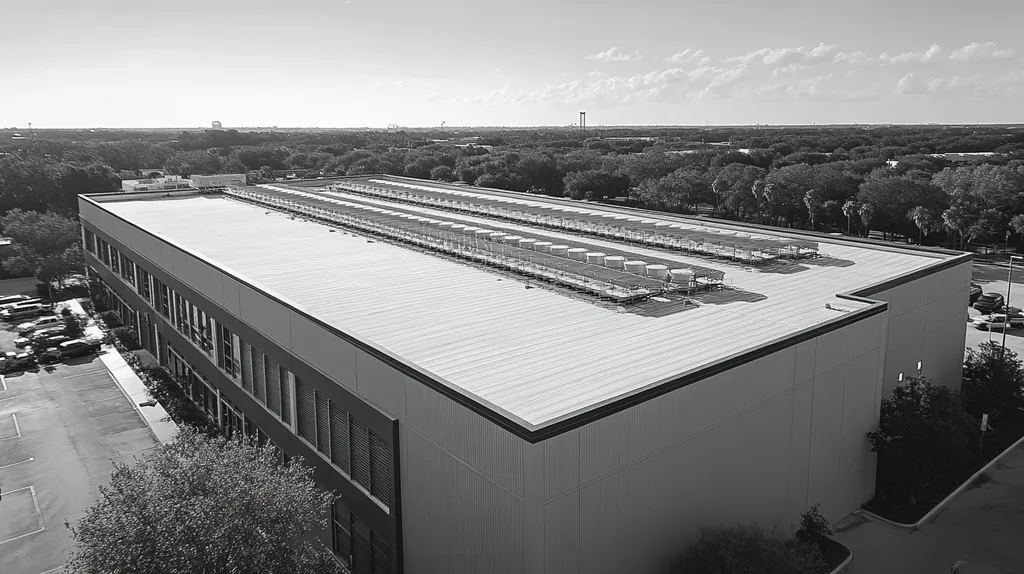Welcome to today’s Battle Royale featuring two roofing heavyweights: “TPO” in the east corner versus “PVC” in the west!
Tonight’s showdown pits these contenders against each other across six punishing rounds designed to test every aspect of their performance for Commercial Roof Longevity.
At stake? Millions in potential costs, decades of building protection, and the critical performance demands of modern commercial and industrial facilities.
Our professional judging panel will evaluate each round on technical merit, real-world performance, and value delivery. After all six rounds, we’ll declare our ultimate champion.
Ladies and gentlemen, facility managers and building owners… it’s time to rumble!
ROUND 1: INITIAL COSTS & INSTALLATION
When facing a commercial roofing decision, the initial investment and installation process can make or break a project’s success. Every dollar spent upfront impacts both short-term budgets and long-term maintenance costs. With material costs rising and skilled labor becoming increasingly scarce, choosing between TPO and PVC requires careful evaluation of three critical factors: material expenses, installation complexity, and project timelines.
Material Expenses
TPO roofing membranes typically cost 15-25% less than PVC alternatives, making them an attractive option for budget-conscious property owners. These initial savings can be significant on large commercial projects where material costs represent a substantial portion of the total investment.
TPO (Thermoplastic Olefin) roofing systems offer competitive pricing and have become increasingly popular for commercial applications. The material’s cost-effectiveness, combined with its easier installation requirements, makes it particularly appealing for large-scale projects. (source: CRS Roofing Blog)
PVC membranes command premium pricing due to their advanced chemical composition and enhanced durability. While the upfront cost is higher, PVC’s superior resistance to chemicals, UV rays, and punctures often justifies the investment.
For pure material cost considerations, the “ADVANTAGE” goes to TPO.
Installation Complexity
TPO installation requires fewer specialized tools and techniques, resulting in a more straightforward process. The simplified welding procedures and lighter weight materials reduce the technical expertise needed for proper installation.
Many contractors can complete TPO installations more efficiently due to its forgiving nature during the welding process. This accessibility helps maintain competitive labor costs and increases the availability of qualified installers.
PVC installation demands more technical expertise and precision, particularly in seam welding. The more complex installation process requires specialized training and experience to ensure proper membrane fusion and long-term performance.
For installation complexity, the “ADVANTAGE” goes to TPO.
Project Timeline
TPO installations typically progress faster due to simpler welding requirements and easier material handling. Quick installation reduces labor costs and minimizes disruption to building operations.
The streamlined nature of TPO installation allows contractors to cover more square footage per day. This efficiency can be particularly valuable in regions with unpredictable weather patterns or short installation seasons.
PVC installations generally require additional time for proper seam welding and detail work. While this extended timeline increases initial costs, it helps ensure proper installation and reduced maintenance needs.
For project timeline considerations, the “ADVANTAGE” goes to TPO.
ROUND 1 WINNER: TPO
ROUND 2: DURABILITY & LIFESPAN
When evaluating commercial roofing systems, durability and lifespan directly impact the total cost of ownership. A premature roof failure can cost businesses millions in repairs, inventory damage, and operational disruptions. Recent industry data shows that selecting the wrong roofing system can reduce a roof’s expected lifespan by up to 40%, making material selection crucial for long-term facility planning.
Material Strength and Resistance
TPO membranes offer reliable UV resistance and flexibility, making them suitable for various weather conditions. Their reflective surface helps maintain building temperature control, but they can be vulnerable to punctures and chemical exposure.
The material’s performance can vary significantly between manufacturers, with some TPO products showing premature aging and cracking in harsh environments. High temperatures and constant UV exposure can accelerate wear on TPO membranes.
PVC membranes demonstrate superior resistance to chemicals, grease, and industrial pollutants. Their enhanced tear strength and puncture resistance make them ideal for roofs with frequent maintenance traffic or equipment installations.
For material strength and resistance, the “ADVANTAGE” goes to PVC.
Life Expectancy
TPO roofing systems typically last between 20 and 30 years when properly installed and maintained. The lifespan can extend even further, up to 50 years, with regular professional maintenance and high-quality installation. (source: Houston Roofing Online)
Environmental factors like extreme temperature fluctuations and chemical exposure can significantly impact TPO performance. Regular inspections become crucial as these roofs approach their second decade of service.
PVC roofing consistently delivers 25-30 years of service, with many systems exceeding three decades. Their proven track record in harsh industrial environments and superior chemical resistance contributes to this extended lifespan.
For life expectancy, the results show a “TIE” between both systems.
Maintenance Requirements
TPO roofs demand regular inspection and maintenance to achieve their full lifespan potential. Seam inspections, debris removal, and prompt repairs are essential to prevent premature deterioration.
The material’s susceptibility to punctures and chemical damage means facility managers must carefully monitor foot traffic and roof access. Annual professional inspections are crucial for identifying potential issues before they become major problems.
PVC roofing systems generally require less frequent maintenance interventions. Their superior chemical resistance and durability mean fewer repairs and longer intervals between major maintenance activities.
For maintenance requirements, the “ADVANTAGE” goes to PVC.
ROUND 2 WINNER: PVC
ROUND 3: PERFORMANCE FACTORS
Performance factors can make or break a commercial roofing investment, directly impacting building operations and maintenance costs. Today’s commercial roofs must handle increasingly extreme weather conditions while meeting stricter energy codes and safety requirements. Understanding how TPO and PVC perform across key metrics helps facility managers make informed decisions that align with their building’s specific needs.
Thermal Efficiency
Thermal efficiency directly impacts a building’s energy consumption and operating costs. In commercial buildings, roof surface temperatures can exceed 150°F during summer months, making heat reflection and insulation critical factors in HVAC performance.
TPO membranes excel in solar reflectivity, with most products achieving reflectance ratings above 0.85. This high reflectivity helps reduce cooling costs and protects the membrane from UV degradation.
PVC roofing offers good thermal performance but typically requires additional insulation layers to match TPO’s efficiency. While both materials meet Energy Star requirements, PVC’s thermal properties can degrade faster over time.
For thermal efficiency, the “ADVANTAGE” goes to TPO.
Weather Resistance
Commercial roofs must withstand everything from intense UV exposure to severe storms and temperature extremes. A roof’s weather resistance capabilities directly affect maintenance frequency and long-term performance.
TPO membranes demonstrate excellent resistance to UV radiation and maintain flexibility in extreme temperatures. Their weldable seams create watertight barriers that resist wind uplift and prevent water infiltration.
PVC systems offer comparable weather resistance but can become brittle over time when exposed to intense UV radiation. While both materials perform well in most climates, TPO’s superior flexibility gives it an edge in areas with extreme temperature fluctuations.
For weather resistance, the “ADVANTAGE” goes to TPO.
Fire Safety
Fire safety remains a critical concern for commercial property owners, with roofing systems playing a vital role in containing and preventing fire spread. Building codes increasingly emphasize superior fire resistance in roofing materials.
TPO membranes provide standard fire resistance and meet most building code requirements. However, their performance in intense fire conditions may not match more advanced materials.
PVC roofing systems offer inherent fire resistance and self-extinguishing properties. These membranes typically achieve higher fire ratings and better prevent flame spread, making them preferred for facilities with strict safety requirements.
For fire safety, the “ADVANTAGE” goes to PVC.
ROUND 3 WINNER: TPO
ROUND 4: MAINTENANCE REQUIREMENTS
Maintenance strategies can make or break a commercial roofing investment, with proper upkeep often determining whether a roof lasts 15 years or 30 years. Recent studies show that neglected maintenance accounts for over 80% of premature roof failures. Understanding the distinct maintenance requirements of TPO and PVC systems helps facility managers develop effective long-term care plans that protect their roofing investments.
Maintenance Frequency and Access
TPO roofs require regular inspections at least twice annually, focusing on seam integrity and surface damage. The material’s lighter color makes it easier to spot potential issues during visual inspections, reducing the time needed for routine checks.
These roofing systems generally allow for easier access during maintenance due to their superior slip resistance when wet. However, their vulnerability to punctures means careful attention must be paid to foot traffic patterns and equipment placement.
PVC systems demand less frequent inspections due to their superior chemical and puncture resistance. Their enhanced durability means maintenance teams can often extend the time between comprehensive inspections without compromising roof integrity.
For maintenance frequency and access considerations, the “ADVANTAGE” goes to PVC.
Repair Procedures
Single-ply roofing systems like TPO offer straightforward repair procedures that can often be completed quickly. TPO’s weldability remains consistent throughout its lifespan, making repairs relatively simple even years after installation. (source: Cloud Roofing)
The material’s flexibility allows for easier patching and seam repairs, though care must be taken to maintain proper welding temperatures. Repairs typically require minimal specialized equipment, reducing maintenance costs.
PVC repairs demand more precise temperature control and specialized techniques to ensure proper membrane fusion. While repairs are generally permanent when done correctly, they require more skilled labor and specific equipment.
For repair procedures, the “ADVANTAGE” goes to TPO.
Long-term Care Requirements
TPO roofing systems need consistent attention to chemical exposure and UV degradation throughout their service life. Regular cleaning becomes essential to maintain reflectivity and prevent chemical accumulation that could degrade the membrane.
The material’s susceptibility to certain chemicals means facility managers must carefully monitor roof exposure to industrial emissions and cleaning solutions. Environmental contaminants can accelerate aging if not addressed promptly.
PVC exhibits superior chemical resistance and requires less intensive cleaning regimens. Its inherent durability translates to fewer long-term care requirements and reduced maintenance costs over time.
For long-term care requirements, the “ADVANTAGE” goes to PVC.
ROUND 4 WINNER: TIE
ROUND 5: SUSTAINABILITY CREDENTIALS
Environmental considerations now drive major commercial roofing decisions, with regulatory compliance and corporate sustainability goals reshaping material choices. Recent industry shifts show over 60% of commercial property owners prioritize environmental impact when selecting roofing systems. Understanding how TPO and PVC measure up against modern sustainability metrics has become essential for making future-proof roofing investments.
Recyclability and Life Cycle Assessment
TPO membranes offer significant end-of-life recycling potential, with many manufacturers now operating take-back programs. The material can be effectively reprocessed into new roofing products, reducing landfill impact and supporting circular economy initiatives.
The manufacturing process for TPO produces fewer harmful byproducts compared to traditional roofing materials. Its simplified chemical composition makes it easier to recycle and repurpose without extensive processing.
PVC roofing presents more complex recycling challenges due to its chemical additives and processing requirements. While recyclable, PVC often requires specialized facilities and more energy-intensive processes to break down and repurpose.
For recyclability and life cycle considerations, the “ADVANTAGE” goes to TPO.
Energy Efficiency and Reflectivity
TPO’s inherent white surface delivers superior solar reflectance, typically exceeding 85% in new installations. This high reflectivity significantly reduces cooling loads and helps buildings maintain consistent interior temperatures.
The material maintains its reflective properties longer than many alternatives, requiring less frequent cleaning or recoating to preserve energy performance. TPO’s resistance to dirt accumulation helps sustain its energy-saving benefits throughout its service life.
PVC systems offer good initial reflectivity but may require more maintenance to maintain performance levels. While both materials meet Energy Star requirements, PVC’s reflective properties can degrade more quickly under intense UV exposure.
For energy efficiency and reflectivity, the “ADVANTAGE” goes to TPO.
Long-Term Environmental Impact
TPO roofing systems typically last between 20 and 30 years when properly installed and maintained. This extended lifespan reduces the frequency of replacement and associated environmental impacts from manufacturing and disposal. (source: Houston Roofing Online)
The material’s chemical stability means it releases fewer volatile organic compounds (VOCs) during its service life. TPO’s resistance to degradation also minimizes the release of microplastics into the environment.
PVC production involves chlorine-based processes that can generate concerning byproducts. While modern manufacturing has improved, PVC’s environmental footprint remains larger throughout its lifecycle.
For long-term environmental impact, the “ADVANTAGE” goes to TPO.
ROUND 5 WINNER: TPO
ROUND 6: SPECIALIZED APPLICATIONS
Specialized commercial applications present unique challenges that can dramatically impact roofing performance and longevity. Manufacturing facilities, restaurants, and data centers each create distinct environmental conditions that stress roofing systems in different ways. Recent industry data shows that mismatched roofing materials in specialized applications account for over 40% of premature system failures, making proper material selection crucial for long-term success.
Industrial Environment Performance
Industrial facilities often expose roofing systems to harsh chemicals, extreme temperatures, and constant equipment vibration. These challenging conditions can accelerate membrane degradation and lead to premature failure if the wrong material is selected.
TPO membranes show adequate resistance to common industrial pollutants but can become compromised when exposed to certain chemicals and oils. Their performance in high-temperature environments near industrial equipment or exhaust systems may be limited.
PVC roofing demonstrates exceptional resistance to chemicals, grease, and industrial pollutants. Its superior durability in harsh industrial environments and ability to withstand constant exposure to aggressive substances makes it the preferred choice for manufacturing facilities.
For industrial environment performance, the “ADVANTAGE” goes to PVC.
Restaurant and Kitchen Applications
Commercial kitchen environments create unique challenges for roofing systems, with constant exposure to grease, oils, and high-temperature exhaust. These conditions can rapidly degrade standard roofing materials, leading to expensive repairs and potential health code violations.
TPO membranes provide adequate initial protection but can show signs of deterioration when consistently exposed to kitchen exhaust and grease. Regular cleaning becomes critical to maintain membrane integrity, increasing maintenance costs.
PVC roofing excels in restaurant applications due to its superior resistance to grease and oils. Its chemical composition prevents degradation from kitchen exhaust and makes cleaning more effective, reducing long-term maintenance requirements.
For restaurant and kitchen applications, the “ADVANTAGE” goes to PVC.
Data Center and Critical Facility Applications
Data centers and critical facilities require exceptional temperature control and leak prevention to protect sensitive equipment. These facilities cannot tolerate even minor roofing issues, as water infiltration can lead to catastrophic equipment failures and service interruptions.
TPO systems offer excellent temperature control through superior reflectivity and efficient heat management. Their reliable seam strength and puncture resistance provide good protection against water infiltration when properly maintained.
PVC membranes deliver comparable temperature control but offer enhanced protection against leaks through superior chemical bonding at seams. Their durability and resistance to ponding water make them slightly more reliable for critical applications.
For data center and critical facility applications, the “ADVANTAGE” goes to PVC.
ROUND 6 WINNER: PVC
AND THE WINNER IS…
After six punishing rounds of technical evaluation, ladies and gentlemen, we have our verdict! With a score of 3-2-1, TPO claims the Commercial Roof Longevity Championship belt!
TPO dominated the competition with superior performance in initial costs, thermal efficiency, and sustainability credentials. Its cost-effective installation, exceptional reflectivity, and impressive environmental profile proved decisive in securing this victory.
But don’t count PVC out of the fight! This veteran contender showed incredible strength in specialized applications, particularly in industrial environments and restaurant installations. When facing harsh chemicals, kitchen exhaust, or extreme industrial conditions, PVC remains the undisputed heavyweight champion.
Remember, folks: Every building brings its own unique challenges to the ring. Local climate conditions, facility operations, and specific property requirements can dramatically impact roofing performance. While tonight’s match provides valuable insights, property owners should always consult qualified roofing professionals who can evaluate their specific situation.
In the high-stakes world of commercial roofing, there’s no such thing as a one-size-fits-all champion. The real winners are those who carefully match their facility’s demands with the right contender’s strengths. Choose wisely, and may your roof reign supreme for decades to come!
FREQUENTLY ASKED QUESTIONS
Q. What are the initial costs of a commercial roof installation?
A. Initial costs for commercial roofs can vary significantly between materials. TPO is generally less expensive than PVC, making it more appealing to budget-conscious owners. However, consider long-term maintenance costs as cheaper upfront choices can lead to higher expenses down the road.
Q. How do the durability and lifespan of industrial roofs compare?
A. Both TPO and PVC have comparable lifespans, ranging from 20 to 30 years. However, PVC often surpasses TPO in harsh environments. Durability levels can vary, so selecting the right material based on environmental conditions is crucial for maximizing lifespan.
Q. Which commercial roof performs better under extreme weather conditions?
A. TPO roofing typically excels in thermal efficiency and resistance to UV damage. However, PVC membranes are superior for chemical and puncture resistance, making them ideal for industrial roofs. Your location and climate should influence your choice.
Q. How often should I inspect my commercial roof?
A. Regular inspections are crucial for commercial roofs. TPO systems typically require at least two inspections per year, while PVC can manage with fewer due to its durability. Scheduling inspections can significantly extend your roof’s lifespan.
Q. What are the sustainability aspects of commercial roofing materials?
A. TPO roofs have better recyclability and energy efficiency compared to PVC. Their high solar reflectivity can lower cooling costs. PVC may offer lower initial sustainability benefits due to its manufacturing process, impacting long-term environmental considerations.
Q. Which roofing material is better for specialized applications?
A. PVC roofing is generally better for specialized applications, such as restaurants and industrial environments, due to its chemical resistance and durability. However, each facility’s specific requirements should guide the choice of roofing material for optimal performance.
Q. How can I prolong the lifespan of my commercial roof?
A. To maximize your commercial roof’s lifespan, regular inspections and maintenance are essential. Keep the roof clean from debris and ensure timely repairs of any damage. Selecting the right materials for your building’s specific needs also plays a crucial role in longevity.










